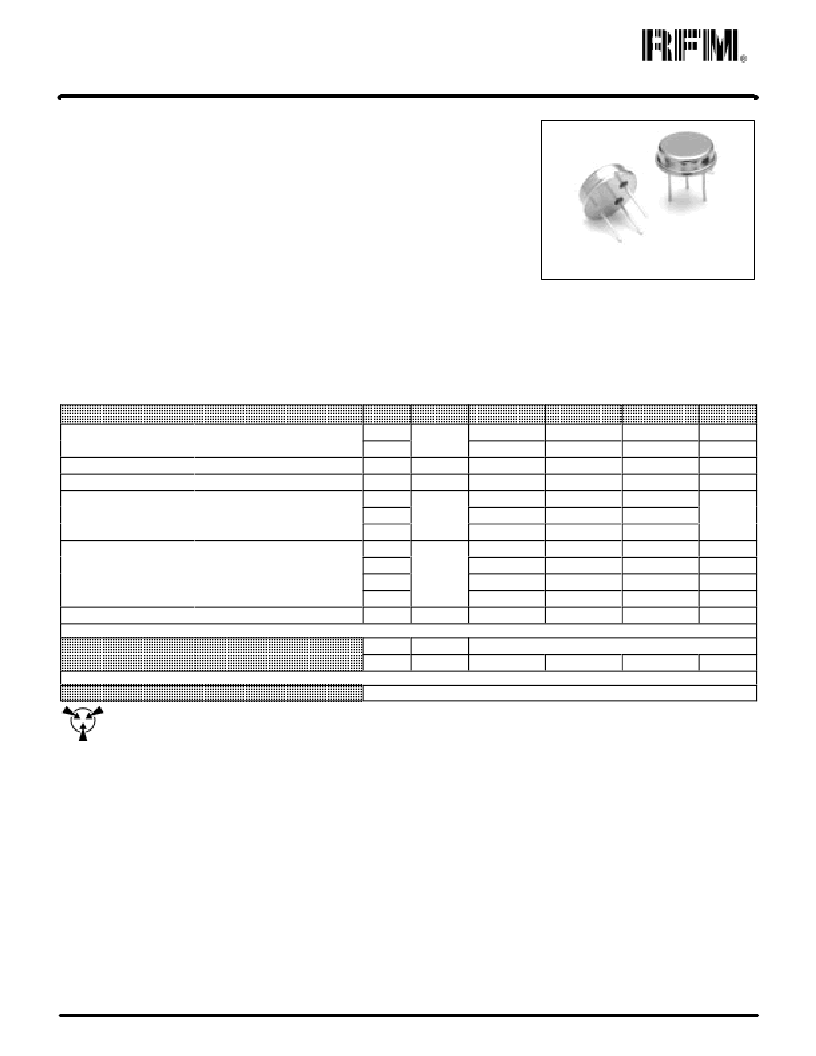-
[北京]010-87982920
-
[深圳]0755-82701186
- 您現(xiàn)在的位置:買賣IC網(wǎng) > PDF目錄373261 > RF1191 Analog IC PDF資料下載
參數(shù)資料
| 型號: | RF1191 |
| 英文描述: | Analog IC |
| 中文描述: | 模擬IC |
| 文件頁數(shù): | 1/2頁 |
| 文件大小: | 74K |
| 代理商: | RF1191 |

RF1191
224.7 MHz
1996 by RF Monolithics, Inc. The stylized RFM logo and RFM are registered trademarks of RF Monolithics, Inc.
Revision: 4/24/97. Page 1 of 2.
Ideal Front–End Filter for 224.7 MHz Wireless Receivers
Low–Loss, Coupled–Resonator Quartz Design
Simple External Impedance Matching
Rugged TO39 Hermetic Package
The RF1191 is a low–loss, compact, and economical surface–acoustic–wave (SAW)
filter designed to provide front–end selectivity in 224.7 MHz receivers. Receiver
designs using this filter include superhet with 10.7 MHz or 500 kHz IF, direct
conversion, and superregen. Typical applications of these receivers are wireless
remote–control and security devices operating in France under PTT Specification
ST/PAA/TPA/AGH/1542.
This coupled–resonator filter (CRF) uses selective null placement to provide suppression, typically greater than 40 dB, of the LO
and image spurious responses of superhet receivers with 10.7 MHz IF. RFM’s advanced SAW design and fabrication technology
is utilized to achieve high performance and very low loss with simple external impedance matching (not included). Quartz
construction provides execellent frequency stablility over a wide temperature range.
Electrical Characteristics
Tolerance from 224.7 MHz
Insertion Loss
3 dB Bandwidth
Rejection
at f
c
–21.4 MHz (Image)
at f
c
–10.7 MHz (LO)
Ultimate
Temperature
Operating Case Temperature
Turnover Temperature
Turnover Frequency
Frequency Temperaure Coefficient
Frequency Aging
Absolute Value during the First Year
f
C
IL
BW
3
5, 6
2, 4, 7
2, 3, 4, 7
±
80
5.0
800
kHz
dB
kHz
2.3
680
50
30
80
500
40
15
2
dB
T
C
T
O
f
O
FTC
|fA|
–35
15
+85
35
°
C
°
C
MHz
ppm/
°
C
2
ppm/yr
4, 7, 8
25
f
C
0.032
<
±
10
1
L
C
2, 7
2, 7
12 turns 28 AWG on Toroid
Lid Symbolization (in addition to Lot and/or Date Codes)
6
50
pF
CAUTION: Electrostatic Sensitive Device. Observe precautions for handling.
RFM RF1191
Notes:
1.
Frequency aging is the change in f
C
with time and is specified at +65 C or less. Aging may exceed the specification for prolonged temperatures above
+65 C. Typically, aging is greatest the first year after manufacture, decreasing significantly in subsequent years.
Unless noted otherwise, all measurements are made with the filter installed in the specified test fixture, which is connected to a 50
test system with
VSWR £ 1.2:1. The test fixture’s L and C are adjusted for minimum insertion loss at the filter center frequency, f
C
. Note that insertion loss, bandwidth,
and passband shape are dependent on the impedance matching component values and quality. The optimum impedance matching component values
are dependent on circuit parasitic losses.
The frequency f
C
is defined as the midpoint between the 3dB frequencies.
Unless noted otherwise, specifications apply over the entire specified operating temperature range.
One or more of the following United States patents apply: 4,454,488; 4,616,197, and others pending.
All equipment designs utilizing this product must be approved by the appropriate government agency prior to manufacture or sale.
The design, manufacturing process, and specifications of this device are subject to change without notice.
The turnover temperature, T
O
, is the temperature of maximum (or turnover) frequency, f
O
. The nominal center frequency at any case temperature, TC,
may be calculated from: f = f
O
[ 1 – FTC ( T
O
– T
C
)2 ].
2.
3.
4.
5.
6.
7.
8.
SAW Filter
TO39–3 Case
相關(guān)PDF資料 |
PDF描述 |
|---|---|
| RF1199 | Analog IC |
| RF1211 | Analog IC |
| RF1254 | Analog IC |
| RF1283 | Analog IC |
| RF1306 | Analog IC |
相關(guān)代理商/技術(shù)參數(shù) |
參數(shù)描述 |
|---|---|
| RF1192-000 | 制造商:TE Connectivity 功能描述:Gas Discharge Tubes 420VDC 5KADC 5AAC 1pF Solder Pad SMD 制造商:TE Connectivity 功能描述:- Tape and Reel 制造商:TE Connectivity 功能描述:GAS TUBE 6MM 420V 20% 5KA SMD 制造商:TE Connectivity / Raychem 功能描述:GAS TUBE 6MM 420V 20% 5KA SMD 制造商:TE CONNECTIVITY RAYCHEM-POLYSWITCH 功能描述:GDT / GTCS26-421M-R05-2 |
| RF1193-000 | 制造商:TE Connectivity 功能描述:GAS DISCHARGE TUBE - Trays 制造商:TE Connectivity 功能描述:GAS TUBE 6MM 90V 20% 10KA SMD 制造商:TE CONNECTIVITY RAYCHEM-POLYSWITCH 功能描述:GDT / GTCS36-750M-R10 |
| RF1194-000 | 制造商:TE Connectivity 功能描述:SURGE ARRESTOR, 230V - Trays 制造商:TE Connectivity 功能描述:GAS TUBE 6MM 230V 20% 10KA SMD 制造商:TE CONNECTIVITY RAYCHEM-POLYSWITCH 功能描述:GDT / GTCS36-231M-R10 |
| RF1195-000 | 制造商:TE Connectivity 功能描述:Gas Discharge Tubes 300VDC 5KADC 5AAC 1pF Axial Thru-Hole 制造商:TE Connectivity 功能描述:- Trays 制造商:TE Connectivity 功能描述:GAS TUBE 8MM 300V 20% 5KA AXIAL 制造商:TE CONNECTIVITY RAYCHEM-POLYSWITCH 功能描述:GDT / GTCA28-301M-R05 |
| RF1197-000 | 制造商:TE Connectivity 功能描述:GTCA28-801M-R05 - Trays 制造商:TE Connectivity 功能描述:GAS TUBE 8MM 800V 20% 5KA AXIAL 制造商:TE CONNECTIVITY RAYCHEM-POLYSWITCH 功能描述:GDT / GTCA28-801M-R05 |
發(fā)布緊急采購,3分鐘左右您將得到回復(fù)。
- VIP會員服務(wù) |
- 廣告服務(wù) |
- 付款方式 |
- 聯(lián)系我們 |
- 招聘銷售 |
- 免責(zé)條款 |
- 網(wǎng)站地圖